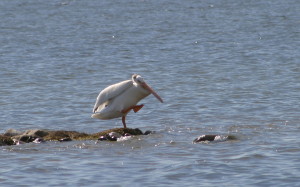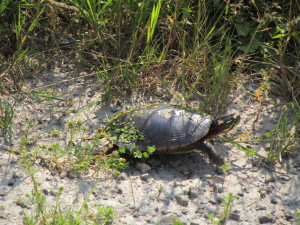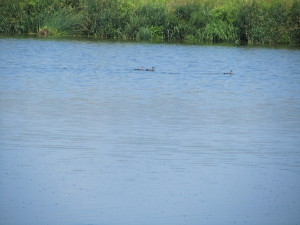Here’s a dancing American White Pelican at Badger Lake in South Eastern Alberta:
Ontario Update
Back from Ontario, with loads of birds seen.
I unfortunately didn’t see either a Chimney Swift or Cerulean Warblers. Some that we did see however, are Red-eyed Vireo and Red-breasted Grosbeak – and others.
As for the cottage, we picked up a good number of new to life and year birds, including Red-eyed Vireos, Pine Warblers and the bonus sight of a Blackburnian Warbler. The bird reserve Island was not very big, quite rocky and barren. The only birds on it were six G.B.H. nests and large numbers of Double-crested Cormorants and Herring Gulls.
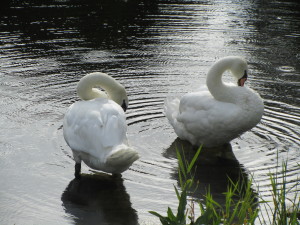
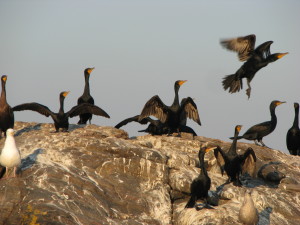
Charleston Lake Provincial Park was a great time with many birds like vireos (Red-eyed, Blue-headed and Yellow-throated), which we saw a great many of, Scarlet Tanagers (probably my favorite sighting of the trip) and many others.
The Bracebridge Sewage Lagoon went well, starting with Song Sparrows and continuing on to Wood Ducks and Ring-billed Gulls. There were some quite interesting things that weren’t birds like the Painted Turtles and a pair of Eastern River Otters. Even so I think the best thing from the Sewage Lagoons was the male Green Heron, a lifer for me.
A nice couple invited us to watch their feeders for a time, and while we were there, we saw our first-of-year Rose-breasted grosbeaks and an Eastern Phoebe!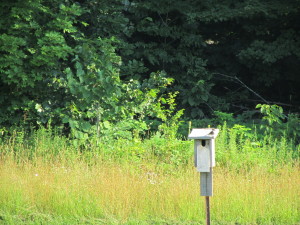
For a full list of what we saw, look at my Lifelist and Yearlist pages.
New email sign up
Just wanted to put it out there, that I’ve got a email sign up for my Blog, located just below the Heron photo on the right.
Ontario birding
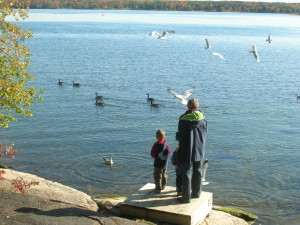
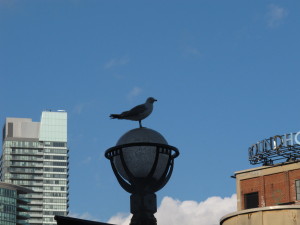
Have you ever wondered about birding in Ontario?
Well, I can tell you first-hand in a month or so.
What kinds of birds can you see there that you couldn’t see at all, or as easily, here in Alberta?
For some examples there are: American Black Duck, Chimney Swift, Black-and-white Warbler, Cerulean Warbler and Northern Cardinal.
I’m hoping to see at least two of the above, Chimney Swift and Cerulean Warbler and some that I didn’t mention there like, Red-eyed Vireo and Red-breasted Grosbeak because where I’m going there’s a good chance of seeing them – and others.
The places we will be going are: Muskoka (Bracebridge); Toronto (Tommy Thompson Park); Charleston Lake Provincial Park, Brockville and possibly Prince Edward County.
Some of our friends have a cabin out on Lake Muskoka, which will get to stay in, and it has a kind of Provincial Island a little ways out. Unfortunately, you can’t set foot on it, but I guess it’s for the best for the birds/animals that live there.
Also, a cousin of our friends has 150 acres of tree full land which he has cut trails through and has said we can use it! (He’d also like to know what kinds of birds live there. My guess would be things ranging from Black-and-white Warblers and Cerulean Warblers to American Kestrels and Ovenbirds!)
It’s been two years since we were last in Ontario, so I can’t wait see what’s out there! Further reports to come when I get back.
Perplexing Plumage
If you aren’t a song expert – and even if you are, you probably have some trouble with female and immature birds – many people are caught out by them. Also, in fall for some birds there is a period called an ” eclipse.” During this period, male birds cast off their flashy breeding plumage and come to look a lot like the females.
This female-like plumage is held very briefly by ducks and other birds in late summer and early fall, and is most noticeable in the males. Eclipse is really the basic or winter plumage, but is worn in summer by most ducks, except the Ruddy Duck which wears eclipse to late winter. Most ducks acquire breeding plumage in the fall, six or seven months before other birds.
I was caught off guard once, (before I learned of eclipses) by what looked like a half-male half-female wood duck – which turned out to be a male in eclipse.
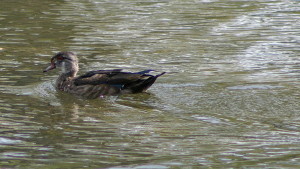
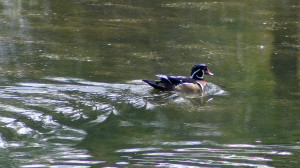
For somebody who didn’t know much about females and immatures, they could have serious problems in the late summer and fall, because in the spring they say: “Why look at a brownish female Yellow-rumped Warbler when you can instead look at the obvious, snazzy male singing away in that that tree?”
An understanding of molting patterns can be a useful aid in identifying many species and in determining their age. Birds need to molt their feathers at certain intervals in order to preserve the structure needed in flight. Molting also can change a bird’s plumage, such as changing from breeding to winter. Very large birds, such as eagles and pelicans, can have complex, irregular molts that last for months. Most birds, however, have regular, predictable molts that occur usually over a few weeks during a period when they are not nesting or migrating.
For those who are interested in learning more about molting, Molt in North American birds by Steve N. G. Howell explains it in four strategies: simple basic, complex basic, simple alternate, and complex alternate.
So get those females and immatures learnt in spring, so that later you’re ready.
In later posts on this subject, I will continue with more on molting and eclipse plumage, and look at some other examples.
Never mind Bat-man, here comes Robin!
Over the years, I’ve had a number of nests in and around my yard. For all my life, American Robins have nested on & off under the deck of my house, last year a pair of Black-billed Magpies nested in a nearby tree (which was later cut down as a new house was built) and three years ago I put up a nest box which, for two years uninhabited, now has a pair of Mountain Chickadees nesting in it.
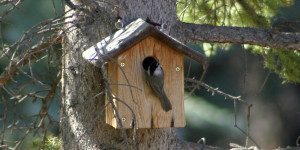
Mountain Chickadees, Black-billed Magpies, American Robins – all birds mentioned in this story: The other day, a Magpie was “inspecting the Chickadees’ home”. Why was it there? Magpies are known to be great egg stealers! What would happen to our Chickadees and their family? Holy heart failure, Batman! Would no one rescue the chicks?
Suddenly, as if out of nowhere, Robin appeared. Stooping in like a falcon…or maybe a bat…Robin smashed at speed into the Magpie, knocking it away from the nestbox, and saving the Chickadees. Holy avian rescue, Batman!
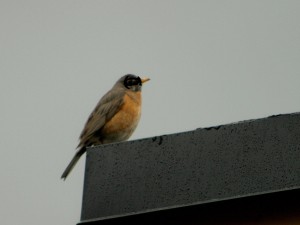
A friend of mine once had a pet Magpie and one time with the Magpie on his shoulder, a Robin came and smashed into his head! (aiming for the Magpie).
If you’ve had a similar experience, I would love to hear about it.
What happened on the Baillie Birdathon?
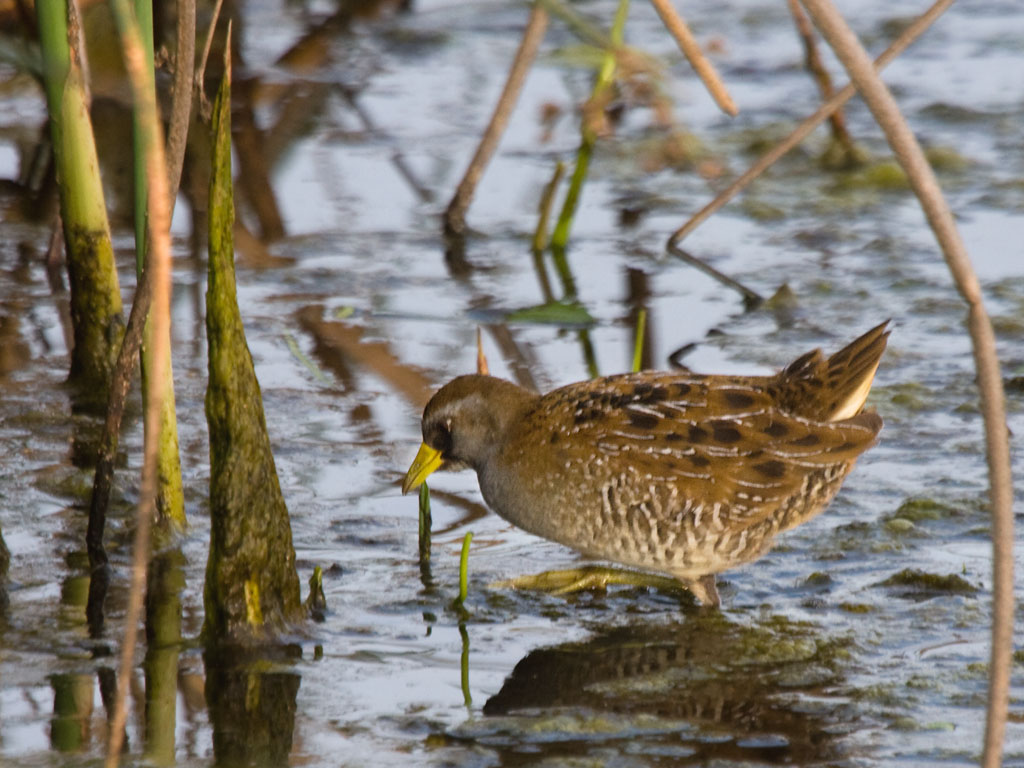
It dumped rain and a rather harsh wind on us all of the first afternoon and evening! But was I put off? No (but my dad suggested postponing it!)
On Friday we went to Inglewood Bird Sanctuary, Weed Lake and as many Marshes and Sloughs as we could get to. On Saturday we went to Lac Des Arc and the Beaver dams and a special little marsh near my house where we picked up an unusual bird in the form of a Sora.
Now, if you’re queasy or your favourite bird is the Rock Pigeon, you might want to skip ahead a paragraph… because before we actually started counting we checked a known Peregrine Falcon nesting site and saw a bird eating a pigeon alive – but not, however a Falcon as you may think; a Common Raven was sitting on a still-flapping Rock Pigeon!
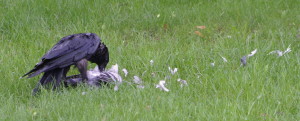
Even with the rain, we saw a total of 50 species that first night! My highlights would be: a Willet, the large number of Red-necked Phalaropes and four Wood Ducks. One disappointment would be the small number of shore birds we saw.
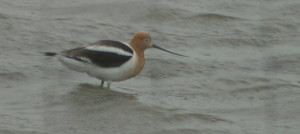
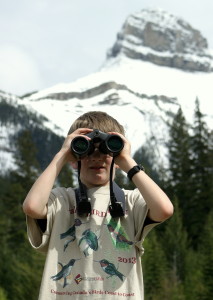
The BowKan Bird count was not quite as successful as last year, but we did see some interesting birds including Yellow and Orange-crowned Warblers, an Osprey and 6 kinds of Swallows.
Click Baillie Birdathon 2013 Species List for a full list of the birds we saw.
My fundraising goal was $300, but with so many kind and generous people around I’ve overshot and raised at least $550, with donations still unfinished. But don’t think it’s too late to donate! There’s still time if you want to.
